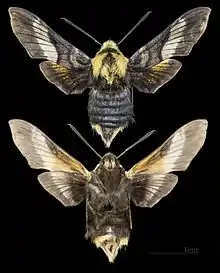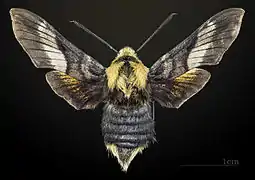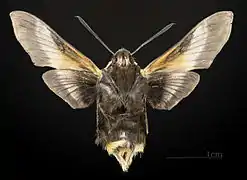Proserpinus flavofasciata
Proserpinus flavofasciata, the yellow-banded day sphinx, is a species of hawk moth which occurs at the edges of, and in clearings in, boreal and mountain forests across Canada, as far south as Maine and Massachusetts in the east and as far north as Alaska in the west. It is much commoner in the west of its range.
| Yellow-banded day sphinx | |
|---|---|
 | |
| Scientific classification | |
| Kingdom: | Animalia |
| Phylum: | Arthropoda |
| Class: | Insecta |
| Order: | Lepidoptera |
| Family: | Sphingidae |
| Genus: | Proserpinus |
| Species: | P. flavofasciata |
| Binomial name | |
| Proserpinus flavofasciata | |
| Synonyms | |
| |
Description
The adult moth is a day-flying bumblebee mimic with a plump black body with yellow markings. The black forewings are marked with a pale band and the hindwings, also black, have a prominent yellow band. It flies in late spring and early summer.
The larva develops through several instars which are dramatically different in appearance. The penultimate instar is pale green with two pale stripes along the sides with a short horn at the tail end. The last instar is brown with black spots and no longer has a horn, just a white-edged black button.
 dorsal
dorsal ventral
ventral
The larva feeds on various Epilobium and Rubus spp, such as Rubus parviflorus.[2] The species overwinters as a pupa in the soil.
References
- "CATE Creating a Taxonomic eScience - Sphingidae". Cate-sphingidae.org. Archived from the original on 2012-11-05. Retrieved 2011-10-25.
- Lady Bird Johnson Wildflower Center — Rubus parviflorus . accessed 2.12.2013
- Proserpinus flavofasciata at Encyclopedia of Life
- Sphinx Moths (Family Sphingidae) In British Columbia: Biological Notes and Field Key, Based on Specimens in the Collection at the Royal British Columbia Museum